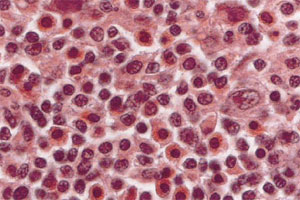Diseases of the immune system
Among the pathologies related to the immune system we can count: immunodeficiency diseases, infectious diseases, autoimmune diseases and allergic diseases (see in Responses of the immune system). Next, we will see which are the most common disorders:
– Immunodeficiency diseases: they come up when the immune system does not function properly, meaning, when the immune response is inappropriate, excessive or deficient. Therefore, the body’s defenses become incapable to fight against the antigen substances (microorganisms, toxins, cancer cells, etc.), causing persistent or recurring infections. It may also implicate the incomplete recovery from a disease or a weak response to treatment and the increase in the impact of cancer and other tumors (neoplasia).
Immunodeficiency can be a hereditary problem and is called congenital or primary immunodeficiency, but it may also develop throughout the years or be triggered by some immunological disease, known as acquired or secondary immunodeficiency.
There are many varieties of the primary immunodeficiency type, but they are rare.In some of them, the causes are referred to the decrease in the amount of white blood cells, even if they maintain their normal functioning.
Likewise, there are congenital immunodeficiencies in which both the amount and work of the white blood cells is normal, but there are faults in other immunological components (deficiencies in the production of antibodies, lymphocytes of phagocyte cells).Secondary immunodeficiency on the other hand, is generally caused by a disease and its varieties are more frequent. Some of the most common disorders only cause a deterioration of the immune system’s functioning, while others can be so serious they wipe out the defensive capability of the body.
Some immunodeficient disorders (primary and secondary) are the following:
1. Severe Combined Immunodeficiency: it is the most serious immunodeficiency disorder, but the least common, in which the absence of B and T lymphocyte functions are combined. In some cases, the natural killer cells also cease working. When this pathology attacks a child under two years old it is very complicated because the immune system is very depressed and the child is left exposed to any type of infection, without being able to properly defend him or herself.
2. Common Variable Immunodeficiency: it is a disorder characterized by the low levels of immunoglobulins of the serum (antibodies) and a higher susceptibility to infections (ears, paranasal sinuses, lungs, etc.). This disease is a relatively common form of immunodeficiency, hence the word “common”. The degree and type of deficiency of the immunoglobulins of the serum and their conduct varies in each patient, hence the word “variable”.
3. DiGeorge syndrome: it is a primary immunodeficiency disease caused by the abnormal development of certain cells and tissues of the neck during the growth of the fetus. As part of this defect, the thymus may be affected and the function of the T lymphocytes, prevented.
4.Bruton agammaglobulinemia (or x-linked): hereditary immunodeficiency disease in which the affected people do not have the ability to generate antibodies (produced by B lymphocytes) which are proteins formed by gamma globulin or immunoglobulin of blood plasma. This is produced because mutations are presented in a gene that is necessary for the normal development of the B lymphocytes and is called Tyrosine Kinase or Bruton’s Tyrosine Kinase. Patients with this pathology are prone to develop infections, especially due to bacteria.
– Autoimmune diseases: they are disorders in which the body manufactures antibodies against the normal chemical substances and tissues of our body. When they attack the internal cells, the reactions can be local or systemic (in the entire body). The most affected organs and tissues are: the blood, blood vessels, skin, conjunctive tissues (cartilage, bones and tendons), the muscles and endocrine glands.
Among the autoimmune diseases we find the following: glomerulonefritis, psoriasis, systemic erythematous lupus, Crohn’s disease (or sickness), multiple sclerosis, vetiligo, rheumatoid arthritis, retinitis pigmentosa, diabetes Mellitus, autoimmune hepatitis, myasthenia gravis, Goodpasture syndrome, Graves disease, Hashimoto’s thyroiditis, polymyositis, pemphigus vulgaris, pernicious anemia, Sjögrens síndrome, among others.
– Infectious diseases; they are caused by one or the combination of microorganisms called pathogens, such as: viruses, bacteria, parasites and fungi. These agents go through the body’s defenses, invade it and multiply.Depending of the microorganism that causes the disease, the infection can be contracted sexually, by air, blood, skin, food, water or insects. It can go from a simple cold to AIDS. Some 30 new diseases have been discovered the last 20 years, among them, Ebola and AIDS.
Among the most well-known and bacteria-caused infectious diseases we find the following: diphtheria, tetanus, ferine cough, bacterial pneumonia, bacterial meningitis, toxic shock syndrome (TSS) and tuberculosis.
Other infectious diseases caused by viruses are: poliomyelitis, measles, mumps, some types of hepatitis, smallpox, rubella, viral pneumonia, common cold, flu, viral meningitis, infectious mononucleosis, atypical pneumonia (SARS) and AIDS.
Among those produced by parasites we find Lyme disease and malaria, and among those caused by fungi, we find blastomycosis, candidiasis and sporotricosis.
Diseases of the lymphatic system
The lymphatic system presents diseases and disorders, some of them simple, but others acute and chronic. They have diverse origins and affect the nodes and lymphatic vessels.
Adenopathies correspond, generally, to the inflammation of one or more lymph nodes and appear after the infection of a nearby area. Its development usually appears the first or second day of the original infection and manifests in the increase in size of the node, reddening and the appearance of pain. Among adenopathies we find: lymphadenitis, tuberculous adenopathy, specific chronic adenopathy and lymphadenomas.
Among the most common disorders that affect the lymphatic vessels we find acute lymphangitis. It is an inflammation of one or more lymphatic ducts and, generally, is a consequence of a bacterial infection (streptococcus). They usually enter the vessels from a wound or infection (generally cellulitis) of some limb, forming irregular and painful lines beneath the skin and they tend to spread from the infected area to a group of lymph nodes.








